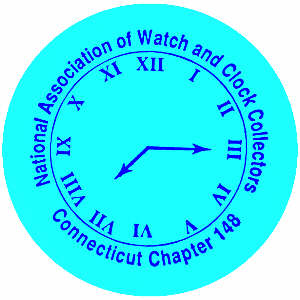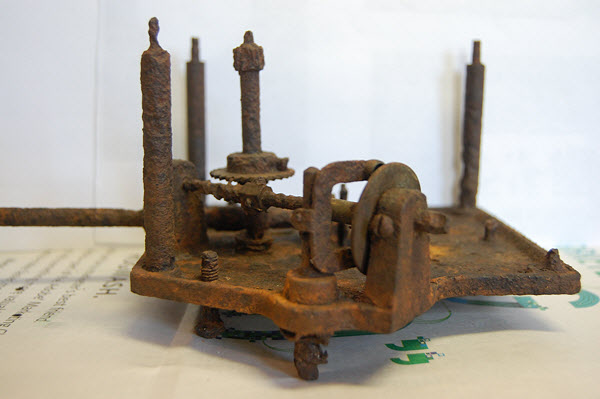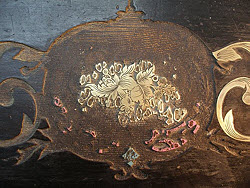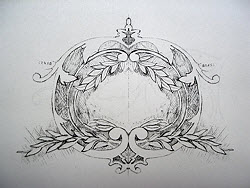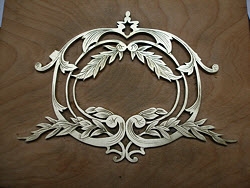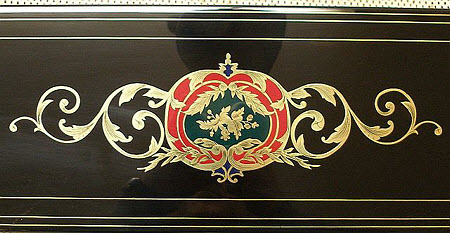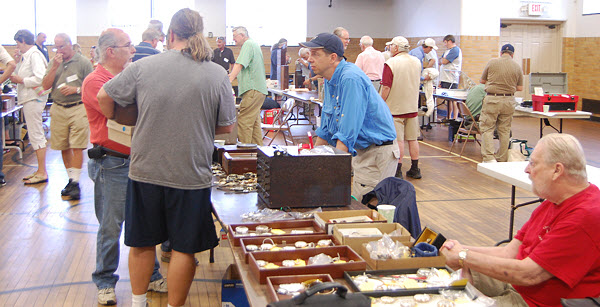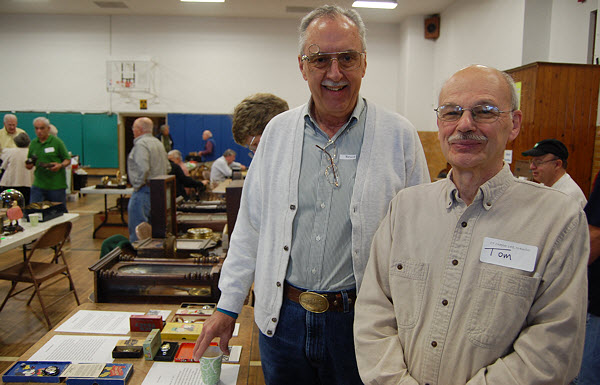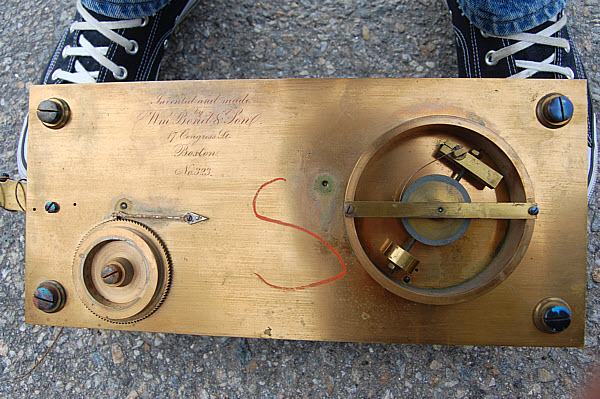Meetings PastNovember 17, 2012 Meeting Highlights Chapter 148 met on the sunny Saturday morning of November 17. Attendance was very good, and mart activity strong. A lovely, ornate, brass movement iron-front shelf clock in mint condition, with case signed J.C. Brown (Forestville, Conn.), ca. 1850, spotted at the table of Jeff Bergman (NJ), attracted much favorable attention. The clock, whose ornamentation included gilded filigree designs and a pair of painted peacocks, found its way to a grateful new home. Members joyously stumbled upon the shared table of David Follett and George Bruno.Happily, this duo, after a lengthy hiatus, once again teamed to bring an educational exhibit of the calibre that elicits quick stops and sharp intakes of breath on the part of passersby. Indeed, David had brought a beautiful example of a mid-17th century bracket clock, which contained a brass movement by Dutch clock maker Solomon Coster. David's recent research has found the clock to be one of only two striking examples known by this maker. (For further information and references, see Chapter 148 highlights, Bulletin No. 366 (February 2007), p. 88. Member Lydia Rufleth brought the incomplete remains of an unidentified iron and brass mechanism she found while hiking in the vicinity of late 19th or early 20th c logging camps in the Adirondack mountains, in hopes that someone might be able to help explain its original use (see photo). (click image for larger view) Please contact chapter 148 if you have any idea of what Lydia Rufleth's incomplete iron and brass mechanism was used for. Our guest speaker was Mary Jane Dapkus (CT), who presented the fruits of 10+ years of research on the early 19th c wooden movement shelf clock makers of the villages of Farmington and Unionville, Connecticut. Begun by accident, this endeavor has uncovered many connections between the clocks of these villages, their makers, and local financiers, as well as with historical events of national significance.One of the many surprises included locating documents related to a hitherto undocumented local legend regarding a team of clock peddlers from Conn. in Illinois and the young lawyer Abraham Lincoln. Together with co-author Snowden Taylor, who had long observed the connections now "fleshed out" by means of primary source documents, in the details of the movements of these clocks, Mary Jane has been working on a series of articles on the subject for future publication in the Bulletin. The chapter extends a hearty thank-you to all the volunteers who helped make our meetings reality in 2012. In particular, we owe a debt of gratitude to officers Cheryl and Al Comen, whose graciousness and hard work kept things running smoothly. Happy holidays! * * * September 15, 2012 Meeting Highlights Chapter 148 met on the morning of Saturday, September 15, a glorious early fall day. Members partook of a sumptuous continental breakfast, visited with friends, and perused offerings at the mart. Trading was brisk.
The American Clock & Watch Museum, Bristol, CT, is hosting its 4th annual Wine and Micro-Brew Tasting on Saturday, September 29, from 4 to 6PM to benefit program development. This event has proved very popular in the past, and anyone interested in attending is encouraged to contact the Museum at 860-583-6070, or to check its web site (www.ClockandWatchMuseum.org, or info@clockmuseum.org) for ticket information. The chapter recently learned that Mystic Seaport Aquarium in Mystic, CT, a non-profit organization devoted to New England's maritime history, is looking for a clocksmith to staff its museum clock shop. The clock shop has in its collection a number of chronometers, sextants, clocks, and timepieces. Sadly, the museum lost its long-time clocksmith, Frank Murphy, age 95, who had kept things running until he passed away this past spring. Interested members are encouraged to contact Mystic Seaport's Interpretation Department (via www.mysticseaport.org) for further information regarding the clocksmith duties and position. Thanks is due to all who helped make our chapter meeting most enjoyable and interesting! * * * July 21, 2012 Meeting Highlights We learned that the American Clock & Watch Museum in Bristol, CT has recently received a generous gift in the form of a Seth Thomas No. 11 double dial perpetual calendar clock. Largely through the efforts of volunteer Mel Brown, its movement has been returned to good running order, and the clock is now on display in the lower level of the Museum's Ingraham Wing. We also learned, however, that in the extreme heat of late, the Museum's ancient, ailing air-conditioning system has finally failed. We suspect that requests to help fund a new, more efficient system would be gratefully entertained by contacting the Museum. George Bruno has been devoting his considerable talent and brain power to the problem of constructing a replica of clockmaker Asa Hopkins' August 1814 patent wheel cutting engine, recently described in detail by authors Bryan Vernimb and Snowden Taylor in Part 1A of their article, "The Hopkins Clockmakers of Litchfield and Harwinton, CT" (NAWCC Bulletin No. 392, June 2011, pp. 278-301). Stay tuned for a report on George's progress. Table holder Vi Beaudreau brought an assortment of vintage Howard and other pocket watches, including a Hamilton Model 4992B, 22j U.S. Government issue military watch, with movement adjusted to 6 positions and a hack feature. Vi patiently explained this means a start-stop feature that allows synchronization with other watches.
view of the meeting & mart, showing member Vi Beaudreau at lower right Chris Brooks reported some unusual finds, most recently in the form of an 18-size Seth Thomas railroad watch dial depicting an unusual locomotive. Some time ago, he had acquired a case for an early Ingersoll "Yankee" backwind pocket watch, with a peculiar off-center movement space. Recently he learned that the case is an example of Ingersoll "seconds" that were given away as prizes in target shooting galleries. One of Chris's favorite discoveries, however, occurred ca. 1967, while he was searching for watch movements to practice repairing for a correspondence course he was then taking. This was a Seth Thomas Model 5, Maiden Lane series, full plate movement, Higgenbothem design, with gravity operated setting and winding. The watch's serial number was 200,021, within the range for this series of between 200,000 and 400,000. Chris's attempts to locate the patent for the unusual winding / setting feature have so far proved fruitless, but we are confident he will eventually prevail. Thanks is due to all who made our chapter meeting most informative and pleasant! * * * May 19, 2012 Meeting Highlights The chapter convened its May meeting early on the 19th, a sunny Saturday morning. More than 90 members and guests attended, transforming the historic Edmund Town Hall gymnasium with wall-to-wall tables into a fully-stocked mart. Congratulations is due to member Larry Byrne, who was spotted wearing a newly-acquired 50-year NAWCC member pin. Peter Lasada presented Chris Brooks with the International Time Recorder time clock steel pendulum rod he was able to straighten for Chris in his machine shop. David Follett exhibited a number of interesting items, including a very rare tall case clock dating to ca. 1740, made by Thomas Lister (1718-1779). The clock was a "country" version of the elegant high style Lister clock pictured in author Derek Roberts' book on British longcase clocks. The meeting featured a traveling exhibit by the American Clock & Watch Museum of Bristol, CT, which provided a sampling of its breathtaking holdings of fine and unusual watches.Curated by Tom Grimshaw, the exhibit included a Waterbury Watch Co. "long wind" pocket watch, precurser to the "dollar watch", in its wonderful original celluloid case. Also on display was a Micky Mouse pocket watch with original decal, fob, and chain, all in the original box, one of only ten known; a Tommy Ticker early character wrist watch dating to the 1920s; a Dudley Watch Co. pocket watch ca. 1920 with synthetic rubies and masonic movement plates, one of only three models known by the firm; a "Bristol Watch Co." Swiss fake pocket watch; and a U.S. Watch Co. pocket watch bearing "1876 Philadelphia Exhibition" stamped on its plates, the historic watch that awakened Europe's watch industry to the advanced state of its American competitors.The exhibit also included a first model Dick Tracy character wrist watch ca. 1934 in its original box--a watch apparently never pictured in horological literature. Until recently, the extraordinary scope and breadth of the American Clock & Watch Museum's watch collection was poorly defined. That the collection is now thoroughly cataloged is due in large part to the efforts of a single volunteer: chapter member and expert watch repairer Bruce Haynes (pictured, along with museum curator Tom Grimshaw), who logged literally hundreds of hours characterizing and describing each watch and watch-related item. Another very knowledgeable member and volunteer, Bill Dunn, commuted over an hour each way to help with the daunting task of physically reorganizing the collection, so that individual watches and their identifying data can now be readily located for exhibit and study. Both Tom Grimshaw and the author of this article thoroughly enjoyed their involvement with this project.
Bruce Haynes (left) and Tom Grimshaw (right) Thanks is due to all who helped make this meeting a comfortable, interesting, and educational experience! * * * March 17, 2012 Meeting Highlights
Chapter 148 members and friends gathered on March 17, a Saturday morning full of the bright promise of spring. The meeting was very well attended, and trading at the mart tables brisk.This was in sharp contrast to the previous meeting, which actually took place (albeit with sparse attendance) during the height of a heavy January snowstorm. Heartfelt thanks is due to our officers for their extraordinary graciousness and commitment to making our meetings most hospitable and successful!
Items spotted at the mart included a 22j Hamilton military pocket watch with a 24-hour dial and sweep seconds in a shock-absorbant metal case. At an adjacent table, member Sal Santopietro helped me appreciate some notable trends, one of which being the recent sharp rise in prices for some types of watches and watch-related items. For example, prices for certain late 19th to early 20th century Elgin and Dueber-Hampden 18s, 15j pocket watch models in original gold-filled box hinged cases have nearly doubled of late, as have those of vintage pocket watches with unusual or fancy dials. Furthermore, gold filled watch bands and cases are bringing considerable prices as scrap, and we hope that necessity isn't parting horological items from their history. Member James Storrow shared his latest research and restoration project. Previously he had helped restore the historic marble-cased observatory clock at Vassar College, Poughkeepsie, NY. The telescope is now in the collection of the Smithsonian Institution, but an important piece of the observatory system, a chronograph, missing since 1939, was fortuitously located in the attic of an adjacent building. Like the clock, the chronograph was made by William Bond & Son of Boston.Bond had become the first director of Harvard University's observatory in 1839. In partnership with his son, Bond had begun producing astronomical and navigational instruments of extremely fine quality long before the American Civil War. Vassar College, founded in 1861, was one of the first institutions of higher learning in America to offer women a full-range of rigorous academic study under the guidance of leading scholars of the day. After more than a century with an all-female student body, the college extended its scholarly resources to male students beginning in 1969. A female astonomer named Maria Mitchell of Nantucket, MA achieved fame by becoming the first person to discover a comet using a telescope, thereby winning an award offered by the King of Denmark. In 1861, Mitchell, a Quakeress without benefit of a formal education, was recruited by Vassar to be its first professor of astonomy, and its observatory, telescope, clock, and chronograph were built for her use.
Vassar's chronograph (see photo), used to correlate astronomical observations via telescope with time on the regulator clock, is missing several pieces, including its rare early electric coils, recording drum, and pen. Miraculously, James was able to locate the Bonds' original plans for the chronograph in Harvard University's archives. Chapter members Aubrey Kinney and Mel Smith are working with James to restore this important and historically significant object. In addition to helping restore Vassar College's historic choronograph, James is continuing his research on Boston tall clock maker Gawen Brown (active ca. 1750-1775). He is trying to locate examples of Gawen Brown clocks in public or private collections for study and data collection purposes. Anyone with information may contact him through Mid-Hudson Chapter 84. Stay tuned for an update. * * * Meetings In 2011 |
